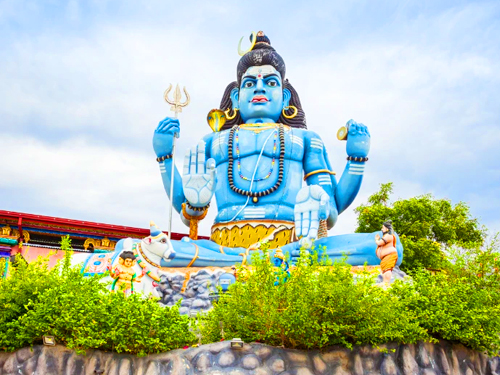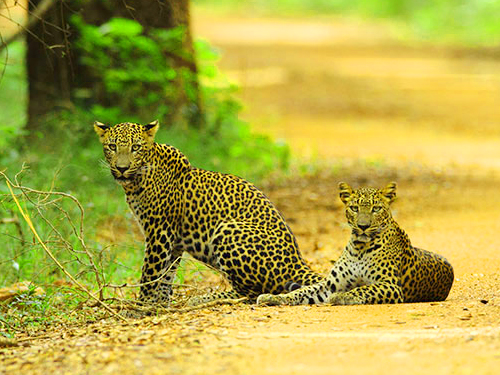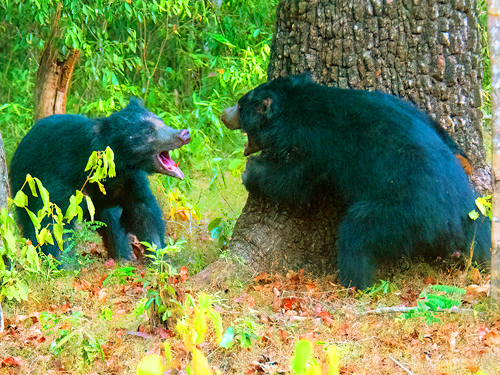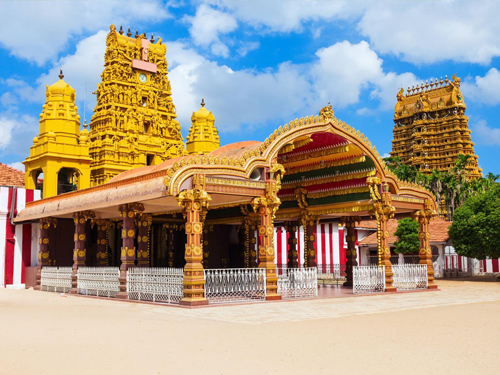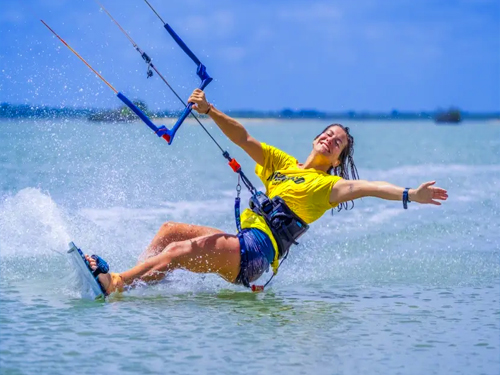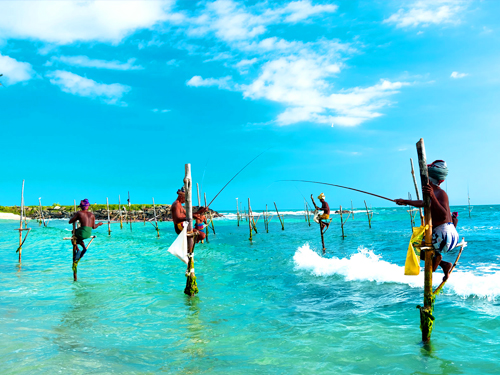Anuradhapura in Sri Lanka
History of Anuradhapura
Anuradhapura can be found in Sri Lanka's North Central Province. You can reach it from Colombo via Kurunegala-Dambulla–Anuradhapura or Kandy–Dambulla– Anuradhapura roads. Or from Puttalam via Trincomalee Road. It is 206 km from Colombo and 138 km from Kandy. Driving distance from Anuradhapura and Polonnaruwa is 101 Km.
Anuradhapura was established by Anuradha, a minister of King Vijaya. King Vijaya, an Indo Aryan of Indo Aryan descent, arrived in Sri Lanka in the later part of the 6th century BC. He established the settlement at the Malwathu Oya side by River Malwatu. Anuradhapura was an independent Kingdom that lasted for close to 15 centuries. It was a major political and commercial center in South Asia during this time.
According to legend, the Sinhala nation was formed from the Indo aryans Vijaya and his followers who arrived on the island in the 6th Century BC. Yakshas were the native clans, while Nagas were their names. King Pandukabhaya, in the 4th century BC made Anuradhapura his capital.
King Asoka, who was the Emperor of India around 250 BC, became a Buddhist. His son and his daughter were ordained Bhikkus and Bhikkuni (Buddhist priests and nuns named Mahinda, Sangamitta), and they became Arhat. [Mahinda in Sinhalese is called Mihindu]
Emperor Asoka sent nine Buddhist delegations in nine countries. Due to close ties with Devanampiya Tsa, King of Anuradhapura and Emperor Asoka, one of the deligations included Arhat Mahinda was sent by Emperor Asoka to Sri Lanka.
Arahath Mihidu and the King Devanampiyatissa met at Mihintale Rock, 12 km from Anuradhapura. They had been meeting on a Poson (June Full Moon day) and they decided to embrace Buddhism. Arahath Mahinda lived the rest of his life in Sri Lanka. He founded the Gauthama Buddha Sasanaya, a Buddhist order of Lord Gauthama Buddha. An era of culture, interwoven with Buddhist philosophy, was born. This created an agricultural-based society. Anuradhapura was later a ruined city. The architectural remains can still been seen, giving a glimpse into the country of that time.
Architecture of Anuradhapura
Ruwanweliseya was the first large stupa built by King Dutthagamani, a practice that would be continued by all subsequent rulers.Stupa construction was evident not only in the Anuradhapura Kingdom, but throughout the history Sri Lanka's. The purpose of a stupa was to enshrine an object for worship. Devanampiya Tissa built the stupa of Thuparamaya. It was built immediately after Buddhism's arrival. King Dutthagamani began the construction of large stupas with the Ruwanweli Seya. It stands 300 feet (91m) high and has a circumference 298 feet (91m).
The Anuradhapura Dagbas, which date back to the Anuradhapura period's early centuries, are so massive that they rival the size of the Pyramids of Egypt.
Another large stupa from the Anuradhapura period is the Abhayagiri stupa, located in the Abhayagiriya monastery complex. Its original height was 350 feet (110m). Mahasen constructed the Jetavana stupa. It is the largest in the nation. Stupas were built on solid foundations that are well-constructed and aware of the specific properties of each material. To lay foundations, the appropriate methods for each material were used.
Large stone columns supported all buildings and provided support for elaborate carvings and sculptures. You can see these stone columns in many buildings, such as Lovamahapaya (brazen castle). These buildings have well-planned drainage systems. Terra cotta pipes were used for water transport to the pits. Some monasteries had large ponds attached, such as Kuttam Pokuna's twin pond. Monasteries were also home to hospital complexes. Timber, bricks, and stones were used to build buildings. Brick was used to build walls and foundations, while brick was used to make columns and foundations. For plastering walls, lime mortar was used.
Anuradhapura's water management and irrigation
The rainfall in Sri Lanka's dry zone is between 50 and 75 inches. Rain-fed cultivation was impossible in these conditions. Early settlers had to find ways to store water to ensure that they could continue to grow crops. To support the cultivations in the village, small irrigation tanks were built. King Pandukabhaya built the Basawakkulama reservoir, which was a medium-sized irrigation tank. A century later, the reservoirs of Nuwara wewa (and Tissa wewa) were built. These reservoirs were expanded by different rulers in the years that followed.
The lake is mostly covered in floating aquatic plants. A hill can be seen in the background. The bank to the left is also lined with trees. An ancient, small and largely unutilized irrigation lake in Anuradhapura.
Vasabha, a 1st century AD ruler, started the construction of large-scale reservoirs. This period saw the construction of the Alahara canal. It was built by damming water from the Amban river in order to divert it to the west for 30 miles (48km). The circumferences for the two reservoirs built during Vasabha's reign are approximately 2 miles (3 km) in length. The Alahara canal was extended and lengthened during Mahasen's reign to provide water to the newly built Minneriya tank. It covered 4,670 acres (18.9km2), had a 1.25 mile (2.01 km), long embankment and 44 feet (13m) high. For this work, he was called Minneri Deiyo (god Minneriya), and is still known as such by those living in the area. Among the many large irrigation projects that were completed during this time was the Kavudulu Reservoir, Pabbatanta Canal and Hurulu Reservoir. These constructions greatly contributed to the improvement in agriculture in the eastern and northern parts of the dry zones. This period also saw the construction of reservoirs using Daduru Oya tributaries, which subsequently supplied water to the southwest part of the dry area. The water supply was adequate throughout the dry zone because of the conservation and distribution. James Emerson Tennent described an ancient irrigation network as: There seems to be every reason to believe, based on their subsequent experiences and the prodigious amount to which they were occupied in the formulation works of this type, that they achieved a facility unsurpassed even by the peoples of other countries.
A partial view of large lake seen from above a tree line. The bank to the left is covered in thick forest and the sun sets over the mountain range to the right. One of the many tanks that make up the intricate network is the Kandalama Reservoir. It is believed to have been built during the second stage of the kingdom.
Upatissa , Dhatusena and others further exploited the water resources in the dry zone. Dhatusena was responsible for the construction of Kala wewa which covered 6,380 acres (25.7 km2) and had an embankment of 3.75 miles (6.04km) length and 40 feet (12m) high. The Jayaganga, a canal that runs 54 miles (87km) from the Kala Wewa to Tissa Wawa, carries water and feeds smaller canals. Dhatusena is also responsible for the construction of this network. The Jayaganga provided water for 180 kilometres worth of paddy fields. Two major irrigation networks were established in the Rajarata region by the end of 5th century. One was supported by the Mahaweli River and the other by Malvatu Oya or Kala Oya. According to the Mahavamsa, many other rulers built irrigation tanks. Some of these have yet to be identified. Large tanks like Padaviya and Naccaduva, Kantale, Giritale, and Kantale had been built by the 8th century. This further expanded the irrigation network. From the 8th century until the end of Anuradhapura Kingdom's reign, however, there was not much activity in the construction and maintenance of irrigation works.
Places to visit in Anuradhapura
King Devanampiyatissa (250 - 210 BC), who donated the Nandanavana, Mahameghavana to the bhikkhus, built the first Sangharama or Monastery within the Mahameghavana. This place was originally called 'Tissarama. 'Mahameghavanarama and Mahameghavana were donated to the bhikkhus. Mahavihara has been the home of the Sri Lankan community of bhikkhus since the Mahameghavana was built. The Triptaka and the Commentaries (atthakatha), were written by Mahavihara's bhikkhus. Mahavihara had a direct impact on the religious, political and economic fields as well as the cultural. This area could be found the Sri Maha Bodhi and Ruvanveli Siya, as well as Thuparama.
Ruvanveli seya, the first stupa built in Sri Lanka, is revered with great respect. It is also known as Mahaseya, Ratnamali and Swarnamali seya in different literary works. The foundation of this stupa was laid by King Dutugemunu (161 to 137 BC). It is bubble-shaped. It measures 150 feet in height. The relic chamber was used for paintings. Most of the Anuradhapura rulers, as well as the whole country's rulers, contributed to its restoration after King Saddhatissa.
The unique feature of this stupa is its elephant-faced wall that runs between the stone-paved terraces and the flight stairs. In the same way, there are also four vahalkadas. The stupa now stands at 350 feet in height and has a circumference of 300 feet.
Ruvanveli Maha Seya, an important monument, has been venerated by both local and international Buddhists. Each July, a special offering with one hundred thousand jasmine blooms is made to mark reverence.
Mirisawetiya Dagoba was said to have been the first dagoba constructed by King Dutugemunu, the Great, who ruled Ceylon from 161 to 137 BC. It measured sixty feet high by five hundred and sixty inches in circumference. Later, it was rebuilt and expanded by the various Ceylon kings. Historical legends mention this dagoba as one of the most important dagobas at that time.
This dagoba can be found in the Anuradhapura District, North Central Province of Sri Lanka. It is believed that it was built by Gautama Buddha at his feet in a sacred location. According to history, one hundred ninety thousand Arahants visited this area to offer and build this dagoba. Anuradhapura, Ceylon's capital during 161 to 137 BC was when this dagoba construction was completed.
According to the Mahavamsa, King Dutugemunu used to offer the first portion of any food he ate to monks. One day the king ate a chilifish without offering any saguna. He then built this dagoba as a compensation. Another opinion states that the king who visited Tissa Lake to play in the water game kept his victory garland and the sacred relics there. When he returned from the water game, he couldn't shake it so the king enclosed the dagoba. It was then built. The king then saw a six-colored Buddha rosary wrapped around the rosary for the sacred relics. It could be viewed as a ring. According to legend, the Sanskrit word for "circle" was also broken down into "vatta -> Ivatti -> Vati" and given the name "mirisawetiya".
Indian invaders invading Ceylon in the eighth and ninth centuries damaged the Mirisawetiya Dagoba. The dagoba was destroyed several times. King Gajaba I, who ruled between 114-136 AD, constructed a protective covering for the stupa. King Voharikatissa, who ruled from 209 to 231, restored the canopy. King Kasyapa V, who ruled between 914 and 923 AD, rebuilt all of the buildings. King Parakramabahu I, who ruled in Polonnaruwa, raised it to 200 feet and offered monasteries and other services. The government has restored the dagoba which was in disrepair by 1888 and is now available for pilgrims. This place also includes a synagogue, built by King Dutugemunu (650-659 AD), a large palace constructed by King Kasyapa II (659-659 AD) as well as a hair relic from Lord Buddha that King Kasyapa IV (898-914 AD). A building known as "Chandana Palace" is also available.
Thuparama was the first stupa to be built in Nepal after Buddhism's introduction in the third century BC. Mahavansa says it was named Thuparama due to the fact that the stupa (arama) and monastery complex are situated together. King Devanampiyatissa built the stupa to enshrine the right collar bone. King Devanampiyatissa and Polonnaruva have since renovated the stupa. The vatadage, a round relic chamber built around the stupa by King Vasabha (65–109 AC), is a unique architectural feature. The current height of the stupa stands at 63 feet and its diameter is 59 feet. The surrounding buildings include a hospital, image house and a bhikkhuni-arama (chapter house) building.
Abhayagiri Stupa is the second-largest stupa in Sri Lanka. It was built by King Vattagamini, alias Valagamba (89–77 BC). It covers an area of almost 200 hectares. Bhikkhu Fahsein, who visited Sri Lanka in fifth century, stated that there were three thousand bhikkhus living in the Mahavihara and five hundred in the Abhayagiri.
Abhayagiri, which was central to Mahayana Buddhism, reached its peak during the reign of King Mahasen. The presence of Buddhist buildings in Abhayagri's environs indicates that this complex was an important educational institution locally as well as internationally.
The Abhayagiri Stupa was built by King Valagamba in first century BC. It has been called many names including Utara Maha Ceta and Bayagiri. The original Abhayagiri Stupa had three basal rings (pesa vaalu), Hataraskotuva, spire, and an umbrella. Four gateways (ayaka), a stone-paved terrace and an elephant wall are located on the four sides. Beautiful sculptures can be found on the south gate's bahirava figures, Sankha and Padma. These figures are still associated with various rituals and religious performances. Evidence suggests that paintings were present at the eastern gateway. A Sri Pada (sacred footprint) was also found in the stupa terrace. The current height of the stupa stands at 235 feet, while the diameter at its base is 310 feet.
Samadhi Buddha Statue can be considered a masterpiece that demonstrates the skills of the Anuradhapura period sculptor. It is believed that the statue, which is in deep contemplation poses, dates back to the fourth century. It is made from dolomite and is found in the veerasana position, which is a sign of concentration. Evidence suggests that the robe and the body were painted. It appears that the robe, which covers one shoulder only, was glued to the body. It is a beautiful representation of Buddha's deep meditation. The face and body are both beautifully rendered. Excavations were made in 1960 and evidence was found that there was a Bodhi-tree shrine. This is the bodhighara Abhayagiri Vihara.
Abhayagiri Vihara has the best moonstones in Sri Lanka. Abhayagiri Vihara's moonstone No.1 is considered to be the most creative piece of art in terms of conception and execution. Art historians consider it an exceptional example of stone carving due to its realistic portrayal and delicate carvings, such as creeper motif. Near a pancavasa, the No. 1 moonstone can be seen. It is now called the Mahasen’s Palace in Abhayagiri. Scholars have different opinions about the carvings on the moonstone. Professor Paranavitana interprets the carvings in Buddhist terms. Paranavitana believes that the moonstone represents samsara. This is the cycle of birth and death and the path to liberation from it, leading to Nirvana. The same form is used for the moonstone No 2. This can be found on the hillock close to the Ratnaprasada, near the Queen's Pavilion.
This archaeological site, also known as Pankuliya because the Asokarama is found in Pankuliya's village, is also called Pankuliya. There are ruins of an image house, bathing spot, stupa, a building that resembles a long hall, a guard stone and a magnificent Buddha statue. An inscription dating back to the eighth century can be found on the staircase leading to the image house. The dolomite-based statue of the Buddha seated in a reclining position is believed to be from the 9-10th century.
This stupa is located about 400m north-east Vijayarama. There are many opinions. Some believe it to be the 'Pathamaka Ciya', which was built by King Devanampiyatissa between 250-210 BC. It is called the 'Uttara Mesghagiri Vihara' according to an inscription. This image house is considered to be the oldest known of its type in Sri Lanka. The image house in the ruins of a state now closely resembles Jetavana. The statue of the Buddha has fallen to its knees and measures approximately 9 feet in height. There are also ruins of a Stupa. Here is an attani-pillar from the 10th Century. It mentions the name "megiri".
The Kuttam Pokuna, a stunning example of Sri Lankan art & technology, is an outstanding example. These ponds were believed to have been constructed for the water requirements of Abhayagiri Vihara's resident bhikkhus. The terraced stone steps that lead to the water are likely to have been built in the eighth century or ninth centuries. The water to the ponds was first transported to the yard around the ponds, then to the larger pond via an underground conduit. Both ponds were drained through an outlet located at the bottom. The five-headed Naga symbol, which is carved at the entrance of the ponds, is a wonderful work of art.
This building is believed to have been constructed by King Kanitthatissa (164-192 BC). It was used for vinaya purposes by the bhikkhus. King Mahinda II (772-797AC) enlarged the building and placed a golden Buddha statue. According to Kasyapa V's (10th century rock inscription), Ratnaprasada looked like a divine home. The gold Buddha statue was taken by the south Indian Pandya thugs during the reign of Sena I (833-853 AC). Later, it was retrieved from South India and placed here. A large, tall, stone pillar can be seen in the current building. It is remarkable to see the guard stones at either side of its main entrance. This guard stone is considered to be the finest in Sri Lanka. It is also notable for the balustrade connecting to the guard stone.
It is the largest pond in the Abhayagiri complex and it is used to supply water for Abhayagiri Vihara Bhikkhus. It measures 150m in length, 50m wide, and 10m deep. It was built in the third century AC. It is described in ancient texts as 'Maspota Pond'. It is stone-paved in all four directions and has a flight of steps that leads to the bottom. The pond is supplied with water by three underground conduits. Two of the conduits in the north remain operational during the rainy season. The Perimiyankulama and Bulankulama tanks to the north of Pond provide water. A bisokotuwa (sluice door) is located in the southwest quarter.
Vijayarama could be considered a Buddhist monastery of the Abhayagiri monastery compound. It is located approximately three kilometres north of Abhayagiri Stota. This is a pabbata Vihara, where you will find a ruined stupa as well as evidence of almost 25 buildings. Historical information indicates that this monastery was used as a part of the Abhayagiri vihara complex. A large number of copper plates were found in the excavations of the stupa, where the parts of the Pragnaparamita Sutra were written. It is believed that the stupa housed the dharma-dhatu. This clearly indicates that the stupa was used as a Mahayana religious center. Avalokiteshwara Bodhistava and Goddes Tara are two examples of the carvings found here. This monastery complex is located in idyllic surroundings during the Anuradhapura period.
King Mahasen (276-303 A.C.) built Jeetavanarama. King Mahasen was a follower Mahayana Buddhism. Jetavanarama's large stupa is what makes it unique. The Nandana Park owned the premises where Jetavanarama was located previously. It is where Thera Mahasenda taught the Dhamma seven days consecutively. Kitisirimevan (303-331AC) and the kings that succeeded him had constructed all necessary buildings for a monastery.
The Most Attractive Locations in Jetavanaramaya
King Mahasen's Jetavana Stupa is approximately 400 feet high. It is also the third-largest monument and tallest brick-built monument. Nine gold folios, containing the Mahayana Sutra, The Pragnaparamita Sutra were found during a recent excavation. Four vahalkadas (frontispieces), face the four cardinal directions. The mound that was higher than the ground level is where the stupa was built. Archaeological excavations revealed remnants of an elephant wall surrounding the terrace. Other special artifacts have been discovered in excavations, including coins and Chinese ceramicware. The Central Cultural Fund has restored the entire stupa.
Jetavana's singular architectural feature is Pratimaghara (Image House). It is also known as Manimevula Prasada. The monolithic door jamb measures 27 feet in height. This image house is one of the largest in Polonnaruva or Anuradhapura. This padmasana (lotus pedestal), suggests that there was a large Buddha statue. It was estimated to have stood at 37 feet in height. Under the lotus pedestal, you can also see remnants of a Yantragala (stone-reliquary). This was built by King Sena I (833-853 AC), in the ninth century. He also deposited a statue of the gold Buddha here.
Jaya Sri Maha Bodhi, a sacred Bo tree or Ficus religiosa that is located in Anuradhapura's Mahamewna Gardens, Sri Lanka, is the Jaya Sri Maha Bodhi. It is the closest living connection to Gautama Buddha and also the oldest tree that has been planted by humans.
Lord Gautama Buddha, a 2,600-year-old Indian saint, sat down against an Esathu tree, on the banks the Neranjana River, Bodhgaya. The Buddha is believed to have reached enlightenment at this time, when he was seated against the tree. The tree was also given a revered status for his actions. It was dubbed the Bodhi tree and pilgrims were able to see it even during the Buddha's lifetime.
In 236 BC, Emperor Asoka sent the Buddhist nun Sanghamitta Maha Theri from India to Sri Lanka. She carried with her a southern branch from the original sacred fig. Devanampiya Tissa received the ceremonial branch. He was one of the first kings to rule Sri Lanka and was responsible for the introduction of Buddhism. Tissa planted the Bodhi branch in Anuradhapura's Royal Park in 288 BC.
Since then, the Jaya Sri Maha Bodhi as it was known has been protected and cared for by dedicated kings and Buddhist monks. Over the centuries, many statues, water canals and golden fences have been constructed around the tree. Many vows and offerings have also been made by Buddhists at its foot.
By car from Colombo to Anuradhapura
You can drive 212 km from Colombo to Anuradhapura by private car or taxi. The A28 route will take you about 3 hours 40 minutes. Alternate routes are also available with a difference of only 5 minutes. It is via Anuradhapura-Padeniya Highway. It takes approximately 3 hours and 45 minutes to drive from Colombo.
By bus from Colombo to Anuradhapura
Bus travel is the best option if you are looking to reduce costs. Regular buses depart from Colombo Bastian Mawatha Bus Terminal and travel to Anuradhapura in both AC and non-AC. It departs four times daily. It takes 5 hours 15 minutes to get there.
By train from Colombo to Anuradhapura
Train travel is the cheapest way to travel and also offers comfort. From Colombo, it takes approximately 5 hours to get to Anuradhapura by train. It also costs only Rs. 260 Sri Lankan rupees. There are frequent trains. Some of them are overnight trains. At 8:45 am, the Colombo Fort is the departure point for the earliest train.
Hours of operation for the tourist office are,
9.00-16.45 on weekdays, and 9.00-13.00 on weekends.
7.00 to 19.00 every day. The ruins are also open 24 hours a day.
Ticket is,
$25 and valid for one day after purchase. Entry to the Isurumuniya monastery or to the bodhi trees is charged separately at 200 rupees.

 Safe Travels
Safe Travels Français
Français Deutsch
Deutsch עִברִית
עִברִית Italiano
Italiano Nederlands
Nederlands Polski
Polski Pусский
Pусский Español
Español

